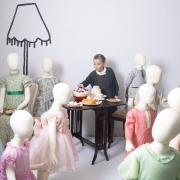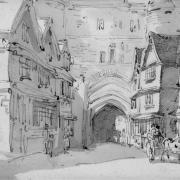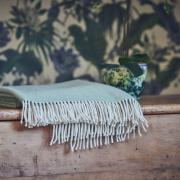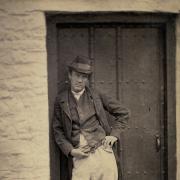For years no one has been able to wander at will around the Saloon at Saltram. This lavish room’s interior was designed by Robert Adam in around 1768. He was a highly fashionable choice for Saltram’s owners, John and Theresa Parker, and no expense was spared, including the carpet.
Adam designed a huge 13.5m x 5.9m one-off carpet to echo the pattern of the exquisite plasterwork ceiling above, with festoons of flowers and ribbons, bands of diamonds and fans in pinks, blues, browns and greens.
Curator Zoe Shearman says: ‘It wasn’t until the 1750s that carpet factories were set up around London and in Axminster, providing wealthy homes with warm, colourful and luxurious floor carpets. With its sheer size, beauty and novelty, the Saltram carpet must have been a truly impressive sight – and it still is today.’

She adds: ‘The Saloon was part of a scheme of fashionable improvements at Saltram, a space for extravagant entertaining, laughter and making social and political connections. And the carpet was at its heart, with the chairs, tables and torchères all arranged around the edges to allow the 3D-effect of the design to really shine.’
But for decades, visitors were unable to appreciate Adam’s scheme as it was meant to be, or to see the details and artworks in an elegant, harmonious whole.
‘For a long time the fragility of the carpet stopped visitors from entering all but the edges of the room,’ says Zoe. ‘Rolling one end protected the carpet but meant people were passive observers of the room and could not see the carpet in its entirety.

‘We then commissioned a drugget, a protective floor covering for part of the space. This allowed visitors to walk the length of the room but obscured the beautiful central medallion of the carpet’s design.’
The carpet is the most significant in the National Trust’s care, but a solution has now been devised, with the help of a local company with a link to Saltram’s past.
Axminster Carpets, whose founder, Thomas Whitty, wove the original carpet in 1770, has recreated two partial copies that can be laid over the original. These will allow visitors to enter and appreciate the room as John and Theresa Parker did, while protecting the precious original carpet.
The company rebuilt its largest loom to enable the weave, the most complex commission it has undertaken in its 268-year history.

The six-week reweave involved 22 thread colours and 96,130 changes of bobbin (the cylinder on which the yarn is wound), each change taking from three hours to one day to complete.
Axminster Carpets’ design and innovation director Gary Bridge says: ‘Building the 15ft loom was a huge task that took 20 months. It is the largest 8-pitch mechanical loom in existence, allowing for a fine, detailed weave on a great scale.
‘In more than 40 years in the industry, this is the most complicated weave I have ever worked on – and I believe the most complex ever attempted.’
Most of the wool was British, specially dyed to give an appropriate antique appearance. Gary and his team made more than 50 visits to Saltram to check thread colours against the original carpet.

The full-length protective reweaves, each covering two-thirds of the carpet’s width, will be regularly rotated. Initially, one copy will be placed along the fireplace wall; after 18 months to two years, it will be cleaned, repaired and stored by bespoke flooring specialists Linney Cooper and the second copy will be laid along the opposite wall. This approach will allow the original carpet to rest and extend the life of the reweaves to up to 30 years.
Zoe says: ‘The original carpet was woven at Thomas Whitty’s Axminster factory, probably by his wife and children, who would have sat alongside each other as they hand-knotted the wool. Because of its size and complexity – with its many decorative motifs – we think it took about a year to complete.
‘We’re very grateful to the teams at Axminster Carpets and Linney Cooper, whose expertise in design, hand-finishing, installation and ongoing care has enabled us to complete this once-in-a-lifetime project.’



























